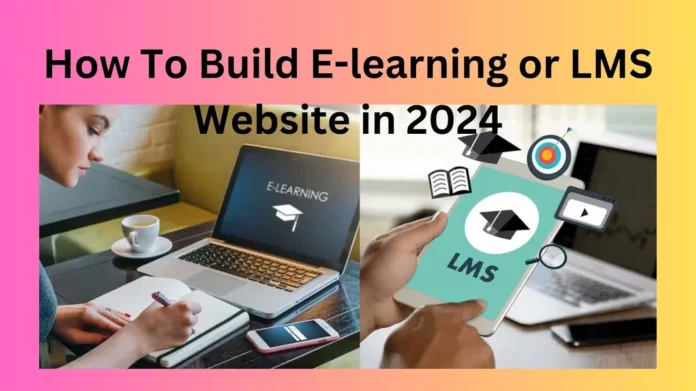In the age of digitalization there is a demand of online educational platforms has been exploding. Due to the increasing demand for remote working and the demand for flexible learning, establishing an e-learning as well as a Learning Management System (LMS) website could be a lucrative business.
If you’re an educator seeking to connect with a larger audience or an entrepreneur looking to capitalize on the market for e-learning, creating an effective platform is vital. Let’s take a look at the steps needed to build your personal website for E-Learning, or an LMS website by 2024.
1: Understanding the Basics
Before diving into the technical aspects, it is essential to know the basics in E-Learning as well as LMS. E-Learning refers to the application of digital technology to access the educational curriculum without the traditional classroom. However An LMS is a computer program that manages documentation monitoring, reporting and distribution of educational classes or training courses.
2: Choose the Right Platform
The first step to build a E-Learning (or LMS website is choosing the appropriate platform. There are many options to choose from including open-source platforms such as Moodle and Open EdX to commercial platforms such as Teachable as well as Thinkific. Be aware of factors like flexibility, scalability as well as the ease of use when making a decision.
3: Define Your Target Audience
Knowing your audience’s preferences is crucial to create pertinent content, features and other elements for the E-Learning and LMS website. Find out who your ideal students are, their preferences for learning and objectives. This information will guide your process of design and development to ensure that your platform will meet the needs of your customers.
3: Design and User Experience
The user experience and design on your E-Learning as well as LMS website play a major part in the success of your website. Make sure you have a clean user interface that is easy to use and facilitates navigation for users. Include responsive design elements in order to ensure compatibility across devices such as tablets, smartphones and laptops.
4: Content Creation and Management
The quality of your content is the mainstay of a profitable E-Learning and LMS website. Create high-quality courses and learning materials that educate and engage your target audience. Use multimedia elements such as online videos, interactivity quizzes and downloadable resources to improve your learning experience. Use a robust and efficient content management system that can organize and distribute your content effectively.
5: Integration and Customization
Integrating third-party software and services will enhance the performance for your E-Learning and LMS website. You might consider integrating payment gateways for the monetization of your site, communication tools to facilitate instructor-student interaction, and analytics tools to track the performance of your users and their engagement. Furthermore, consider modifying the system to fit your company’s image and distinctive value offering.
6: Security and Compliance
The security and safety with the requirements of an E-Learning as well as LMS website is essential. Take measures such as SSL encryption as well as secure authentication protocols regular security audits, and more to safeguard the privacy of your users and to stop unauthorized access. Be sure to adhere to the industry’s guidelines and norms, including GDPR and COPPA to ensure legal compliance and establish confidence with your customers.
7: Marketing and Promotion
After the E-Learning or LMS website is up and running It is essential to promote and market it efficiently. Make use of digital marketing strategies like SEO (search engine optimization (SEO) as well as marketing via social media and email marketing campaigns as well as content marketing to draw customers to your website. Partner with influencers, work with educational institutions as well as participate in industry-related events to increase your reach.
8: Feedback and Iteration
Continuous improvement is essential for the growth of your E-Learning as well as LMS website. Ask for feedback from your instructors, students and other users to determine areas that need improvement and to identify areas for innovation. Update your features, content and functions based on feedback and the latest developments in the field of online learning.
Conclusion
Making an E-Learning or LMS website by 2024 requires meticulous planning, execution, and constant improvement. If you are able to understand the needs of your group, choosing the best platform and paying attention to the design as well as content and security to create an web-based learning system that has an impact.
FAQs
Q1: What is it cost to construct an E-Learning or LMS website?
A1: The price of creating your own E-Learning (or LMS website is contingent on factors like choice of platform, complex design, features requirements as well as development and design resources. It is crucial to budget for costs like hosting domain registration, domain registration, software licensing, development fees and maintenance on a regular basis.
Q2: Do I require the skills of a programmer to design an online learning website or LMS website?
A2: Although programming abilities can be useful to customize and develop advanced features however, numerous E-Learning or LMS platforms have easy-to-use interfaces and drag-and drop functionality which require only a basic understanding of coding. However, collaboration with an experienced web developer or development team could be required to complete more complicated integration and customization tasks.
Q3: How much time will it take to create an online learning site or LMS website?
A3: The timeframe to build your E-Learning (or LMS website may vary based on factors like the choice of platform as well as the complexity of design as well as content creation and the requirements for customization. In general, it takes between just a few weeks to several months to create and launch an operational platform, including testing and optimization.
Q4: Is it possible to monetize the E-Learning website or LMS website?
There are many ways to monetize your site. to the E-Learning or LMS website, such as selling courses or subscription plans, offering premium content or features including affiliate marketing or advertising opportunities. It is crucial to consider your intended audience as well as your pricing strategy and worth proposition when you’re monetizing your platform.
Q5: How do I make sure that the E-Learning website as well as LMS website?
5: In order to ensure effectiveness on the success of your E-Learning and LMS website, you must focus on providing quality content, delivering a superior user experience, and implementing efficient strategies for marketing and promotion that are constantly evolving in response to user feedback and trends in the industry. The creation of a community that is strong as well as encouraging engagement of students and keeping up-to-date with developments in online education are essential to achieve success.















